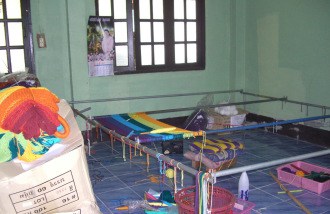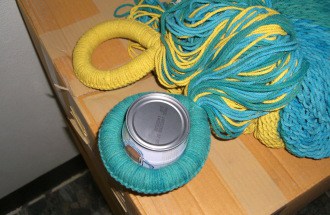This is the raw material that we use to make our hammocks. It’s acrylic spun yarn. It’s normally used for crochet work and embroidery. We are lucky to have a factory nearby that produces it. Acrylic yarn is the yarn with the most natural “feel”.
It feels soft like cotton, yet it’s water and sun resistant. And it comes in many different and very deep colours. We used to have our own dyeing operation (picture), but presently we are happy to get it pre-dyed from the factory.
Before starting to weave we have to wind three different strands of yarn into one. Then we also need to wind the yarn into shuttles or cones (picture) to make the weaving process easier.
All it takes to make a hammock is yarn and this device called a hammock rack. It is welded together at the local workshop from water pipes. The device is much simpler than even the most primitive forms of hand looms. The process is however much more involved and much slower than traditional weaving.
The hammock has just been started. The white yarn is called the dancer, while the purple and yellow yarns are called sleeper yarns. This is now one line of weaving with about 20 loops. Once the hammock is finished it will feature between 350 and 600 lines and anywhere between 30’000 and 150’000 loops each one shaped by hand, and without one single mistake.
We don’t just make hammocks, there is a design sheet for each hammock that tells the weaver which colours to use. All in all there are about 400 different colour designs some of them requiring over 50 colour changes in one hammock.
Just weaving away is not an option, a weaver also has to concentrate on distributing the loops evenly across the hammock, and to adjust tension evenly between dancer and sleeper yarns.
The whole process takes some inspiration from weaving, as there are warp and weft yarns, but also from braiding as the yarns cross each other as in a
braided cloth. For our V-Hammock this gets even more complicated as the yarns also cross each others in multiple directions.
Many days later the woven part of the hammock known as the “bed” is finished. Now it’s time to add the non-woven part called “scale lines” or in
French the “spider yarn”. For this an extra frame is used, and the scale lines are wound around it. Pictures below shows how this is done. Note the
absence of smiles on picture on the left – they are laying scale lines for sitting hammocks, which is probably the most difficult activity in hammock making !
Finally the “eye” is added, the part where the hammock is hung from. And no, still not finished very strict “quality control” is the last step before the hammock is ready for ……You ?









